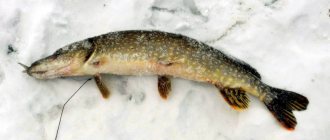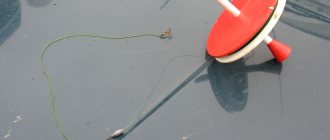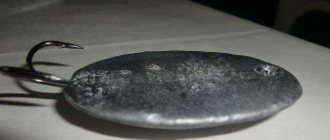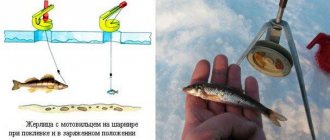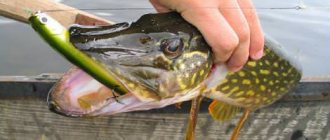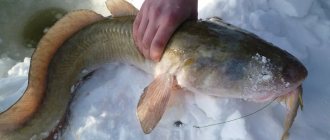How to make a slingshot
To do this, you should find the necessary blank from a tree such as willow, hazel, willow, etc. The tree should be quite simple and the bark could be removed from it without any problems. If you remove the bark, the workpiece turns out smooth without any snags, which is what is required. On such a surface, the fishing line will not get tangled and it will be pleasant to work with the slingshot.
The workpiece should look like a slingshot, with as regular and symmetrical a shape as possible. After the bark is removed from the slingshot, it needs to be dried under natural conditions, which can take up to one week. Do not dry the slingshot in direct sunlight: it may be faster, but the workpiece may crack, which will lead to damage to the wooden workpiece.
Tackle summer zherlitsa. Flyer. Slingshot. Catching pike with live bait. Fishing. Fishing.
Slingshot feeding technique
In order for feeding fish using slingshots to be effective, you must adhere to several rules when using it:
- To achieve an accurate throw, the slingshot should not be held straight, but slightly tilted back. This makes it easier to throw bait over a long distance and set the desired flight path.
- It is more convenient to hold the product vertically rather than horizontally. The tourniquet should be pulled as tight as possible. If the rubber for the slingshot was chosen of poor quality or too thin, it will burst when stretched. Therefore, you should test it before fishing: stretch it strongly several times, pointing it in different directions. A good quality elastic band will stretch evenly and elastically.
- The bait balls must be the same weight and size, otherwise, with the same casting force, they will scatter at different distances.
- You should not change the casting angle - it is easier to control the flight range and accuracy if you throw the balls from one position.
The wind can interfere with the normal flight of the bait ball. If it blows from the side, it will not affect the casting distance, but it will affect the accuracy, and the feed may scatter along the wiring line. In a headwind, the ball will not be able to overcome the resistance; it will be thrown back.
It will take some time to master the skill of using a slingshot. But after just a few dozen throws, you will be able to regulate the force of the throw and set the desired direction of flight.
How to increase your fish catch
In order to increase the fish's appetite, special preparations are used that can activate the bite. The composition of such preparations includes natural biologically active substances called ferromones. It is quite possible that such drugs may be banned, but for now they are on sale and can be purchased.
In case you cannot find the right slingshot, you can cut a slingshot with a much larger fork. It will need to be adjusted during drying. To do this, the ends of the fork need to be tied with a rope and left to dry in this form. After the workpiece has dried, the rope can be removed and the installation of the gear can begin.
In order for the fishing line to be securely fixed to the slingshot, one small screw should be screwed into each slingshot. It is not recommended to hammer nails as they can split the wood. To prevent this from happening, before screwing in the screws, you can drill a hole in their place with a diameter slightly smaller than the thickness of the screws.
To secure the fishing line in the butt of the slingshot, you should cut a groove. For such gear, you can use a fishing line with a diameter of 0.5 mm and a length of about 5-10 m. It is also possible to use a nylon cord instead of a fishing line; after all, pike is a strong fish, and even a specimen can bite a large one.
The fixed fishing line is fixed to the rod using a figure-of-eight winding. To secure the end of the fishing line, you need to make a narrow cut in one of the rods.
To ensure that the tackle is fully equipped, a sliding sinker and a leash with a tee are put on the fishing line. The size of the threesome depends on which specimen of the predator is intended to be caught. It’s worth remembering that the leash should be made of a material that the pike will not be able to handle.
After this, you can go to the pond and try to catch a predator, but first you need to familiarize yourself with the nuances of using a slingshot.
arbalet-airgun
Main types of hunting slingshots “SlingBow”
SlingBow - this mysterious and cute name, in fact, hides a throwing weapon, where rubber bands act as elastic elements. It can be extremely similar to compact compound bows, but for the most part they are nothing more than slightly improved slingshots of our childhood. Only they do not shoot balls from bearings or pebbles, but real arrows, and are intended mainly for hunting. Fans of survival practice may well call them “combat slingshots” - there is actually no difference (see the article “Combat crossbows“)
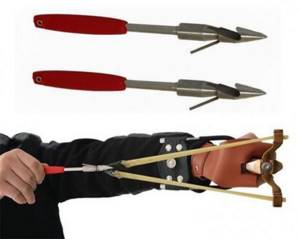
The top photo shows an almost complete analogue of our slingshot-arrow throwers, otherwise known as “slings” (well, that’s what we called them). Here the arrows, or more precisely, the darts, have a hook in the area of the tip, which holds the cords. Once upon a time we made them from electrodes with a special hook cut, but now, as you can see, this is a completely industrial product.
By the way, the top sample itself is positioned as “Powerful Hunting Tool Sniper Slingshot Folding Catapult Wrist Fishing Broadheads,” that is, “A powerful wrist-mounted sniper slingshot-catapult for catching fish” (!) and costs 35.99 USD.
Below is a more sophisticated and sometimes even “tactical” version of such a device. A lot of similar products are sold on Aliexpress or eBay.
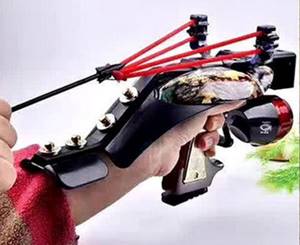
In the photo below we see a slightly different approach, largely borrowed from compound bows. Some of these hunting slingshots are equipped with bows, known as “hairy” or Whisker, and bow sights with several “pins”. Tension and retention of the cords, as well as the shot itself, are carried out using a release.

The author of this creation, called “Falcon Slingbow,” Randy Rathlin is far from a teenager. And his weapon is quite adult, the tension force is 18 kg, or almost 40 pounds. According to the generally accepted classification among bowhunters, this is exactly the minimum level for hunting bows. Moreover, for individual “amateurs”, whom we can hardly imagine, the author produces perfect monsters with a force of 90 kgf! But even if we are talking about pounds, then with such a “slingshot” the enthusiast would quickly find himself in the friendly arms of his respective comrades.
And this is really no joke. Bowhunter Sandy Brady caught the red deer shown in the photo using the Elite Slingbow hunting slingshot at a distance of just under 15 meters (how he got there is another story, one word - well done!).

You will laugh, but not only, say, hares, but even wolves were and are still hunted using... a whip. This weapon is not a remote weapon, but a so-called “hand-held” one, but it is very effective, and, moreover, like slingshots, it is now a common product that can be purchased in a specialized store (see “Combat and hunting whip”).
Gearhead Archery T15 Pro Bows - Bow Slingshot or Horned Bow?
Anyone who can immediately name the... er... construction depicted in the first photo can immediately be awarded the title of archery guru of the 3rd rank ahead of schedule. Although fans of compound bows can easily guess its purpose - by the characteristic loop on the string, etc. “hairy” shelf “Whisker”.
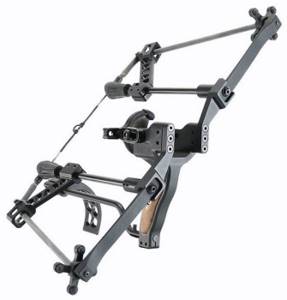
This unusual throwing weapon with the impressive name "Gearhead Archery T15 Pro Bows" actually has something to do with bows. More precisely, before us is a kind of centaur, made up of a “slingbow” hunting slingshot and some bow structural elements.
Regular “SlingBows” are very similar in appearance to classic slingshots, except that due to the serious tension force, there is a wrist rest in the base. And so from the state of Wisconsin I decided to bring the “slingshot” shooting technique as close as possible to the archery technique that is much more familiar to bowhunters. The result of research in this direction was the “T15 Pro Bows”.
It has both rubber bands and a bowstring with the already mentioned release loop. STS vibration dampers are installed in the base. The draw length is from 18 to 32 inches, the tension force is up to 29 lbs, that is, according to Russian legislation, the sample falls under the category of throwing weapons. This is already quite a hunting indicator. The manufacturer itself positions the “T15”, made of aluminum and stainless steel, mainly as a device for bowfishing – bowfishing:

For which those who wish can purchase a special body kit:
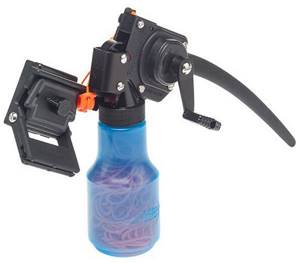
As you can see, this is a fairly simple device, where instead of an inertia-free coil for laying the line, a regular plastic flask is used. By the way, something similar for bowfishing with a crossbow or bow can be built from an ordinary PET bottle, except that the installation itself will have to be done carefully by hand, and not using a mechanism.
The hunting slingshot bow “Gearhead Archery T15” is available in two versions, the second is “T15 XL” (pictured) - as the name suggests, the dimensions are even closer to compound bows, its height reaches 23 inches instead of 16 for the “T15 Pro” . It also has a classic 3-pin bow sight in its base.
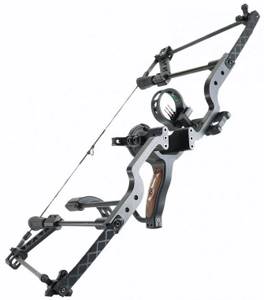
By the way, since it had to be said, an unusual appearance is inherent in all products, which produces a fairly wide range of arrow throwers. Here the photo shows the “T30 CARBON FIBER COMPOUND BOW”, a typical representative of the entire model line.

It feels like the developers there are led by a former civil engineer - that compound bows and crossbows are very reminiscent of some kind of truss structures, something like railway bridges. Obviously not elven devices; it’s more likely that gnomes could have created something similar. Only not Tolkien’s, but Cruz’s from the “By the Great River” series, greedily adopting the achievements of a fragment of technocratic earthly civilization that has fallen into their pristine world.
A few words about bowfishing in Russia
Immediately an explanation. In Russia, bowfishing, that is, “hunting” for fish with a bow, as with any throwing weapon, is prohibited. Usually in regional documents it looks like this: “Users of aquatic biological resources do not have the right to extract (catch) aquatic biological resources using sharp fishing gear, with the exception of recreational and sport fishing carried out using special pistols and shotguns (hereinafter referred to as spearfishing).”
As you can see, there are exceptions - these are guns and crossbows for underwater hunting. And the whole difference lies in the very name of this type: shooting is carried out from an underwater position, that is, no equipment of the shooter should be on the surface. And therefore, ordinary bows and crossbows are not even technically suitable for this, since their elastic elements are not designed to work in a dense environment.
Although, if everything is in order with the money to purchase a new bow, then why not try, naturally, exclusively for experimental purposes:
However, if you really become interested in this matter, you will be able to find opportunities for legal bowfishing. For example, in private farms with artificial breeding of fish, mainly carp and grass carp. Of the “wild” species, the most common is pike, which, with skill, can easily be seen under a layer of water.

"STS Raptor" - Jurassic bow
This photo fully corresponds to the phrase “Don’t believe your eyes!”, here everything in reality is not what it seems.
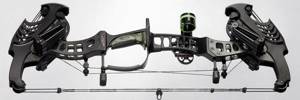
Firstly, this is by no means a virtual sample of a bow in the “Hi-Tech” style created in a 3D editor, but a real serial product, sold and bought for shooting and hunting. Secondly, this is not a bow at all, but the most literal hunting slingshot “slingbow”.
Archery (Shoot Tech Systems) generally stands out for the extremely non-standard appearance of its products, in particular, the AR-480 and AR-480 Mark II crossbows. But the point is not in appearance, but, say, in the double bowstring system, which allows you to shoot not only arrows, but also steel balls, acting as a schnapper. Moreover, a 7-gram projectile develops up to 480 fps, or 146 meters per second. But let's return to the hero of our story today.
So, its name is “ RAPTOR 28 ” (28 is the distance in inches from the axis to the axis of the blocks, ATA). The prototype that appeared back in 2009 bore the same name - in the wake of the popularity of the most memorable characters of Jurassic Park. And it was there that the developers first used the dual string system.

What does this give? Take a look at the photo. The upper bridge between the bowstrings allows the use of classic archery arrows, only with the shank turned 90 degrees. Below there is a “nest” for steel balls, but not a simple one, but a magnetic one - it’s clear why. Speed indicators in schnapper mode are up to 485 fps, depending on the type (and weight) of the projectile, and the 350-grain arrow accelerates to 295 fps, that is, 90 m/s.
By the way, our old friend, the Bavarian Jörg Sprave (Sprave), shot a “Raptor” through a chronograph and got a real 488 fps, or 149 m/s with a 10 mm ball (the weight, alas, was not indicated). The 12mm analog showed 119 meters per second. To be honest - very, very impressive!
Now comes the fun part. The Raptor does not have traditional elastic beam elements, that is, flexible shoulders; the entire mechanics are based on rubber bands (6 for each shoulder - see photo), which classifies the product into the “slingbow” category. The tension force is adjustable from 40 to a solid 80 pounds, and its release is also adjustable and ranges from 60-80%.
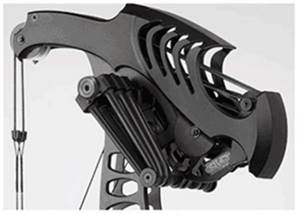
The disadvantages of such a unique sample arise from the design features. This is an immediately noticeable complexity of the units (photo below), a certain bulkiness, and most importantly, fairly rapid wear and the appearance of “fatigue” of the rubber bands. Replacing them is not very difficult; they themselves are sold in sets plus the necessary silicone lubricant.
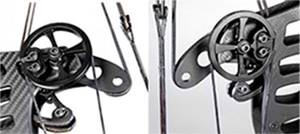
The manufacturer recommends its product for hunting use - with balls for “small game”, that is, small animals and primarily birds, and with arrows - for any game, as with ordinary blockers. However, we were never able to find any descriptions or videos of hunting scenes from “Raptors.” Apparently, although this is an extremely interesting (though not cheap), it is still more of an entertainment device.
"Hawaiian sling", or slingshot for the guerrilla
Remember, in your pink childhood, from an ordinary spool of thread and an elastic band from panties, we built a formidable weapon for throwing pencils? So, without knowing it, the younger generation reproduced the design of the so-called Hawaiian Sling, or Hawaiian slingshot:

Why Hawaiian? - the devil knows. Perhaps, from time immemorial, the islanders used just such devices to hunt one of their main foodstuffs - fish. But where did they get rubber bands before the invention of rubber... Most likely, primitive in comparison with modern underwater guns and crossbows, but a fully functional device, it was popular among many tourists.
As you can see, this weapon is specifically for underwater hunting. Even in the simplest version, the tube-barrel is made of wood to ensure the buoyancy of the instrument.
Even entrepreneurs could not pass up such a tempting opportunity - what kind of amateur activity is this when everyone they meet is able to build such a wonderful device for themselves? For free! Here, you get a real industrial product.
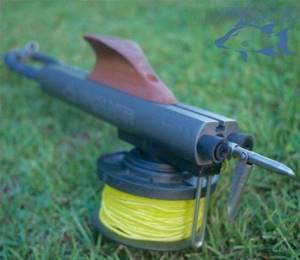
The photo shows the first version of not just some Hawaiian Sling, but a whole “Guerrilla sling”, that is, “Guerilla Slingshot”. Oh how! The wooden fin on the hull, presumably, provided at least some buoyancy and served as a convenient handle for carrying or catching floating weapons at depth.
However, he was not satisfied with his brainchild, and “Guerrilla sling 2.0” was born:
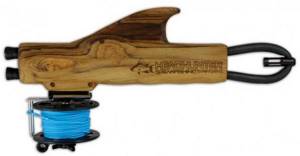
The hull is entirely made of Burmese teak, so its seaworthiness is excellent. Other changes were made to the design, in particular, increasing the range by as much as 33 percent.
Lastly, the Guerrilla Slingshot 2.0 is priced at $200. By the way, the manufacturer produces not only a whole range of ammunition, consumables and accessories, such as harpoons, tips, reels, cords, special gloves, but also traditional T-shirts and caps for such companies with their own symbols.
Here, comrades, learn how you can literally build a profitable business from scratch. These are not school spools of rubber bands for you (us)…
PS To be honest, we can’t quite imagine a partisan hanging around underwater and waging an invisible battle with chubs and pikes. For the purposes of the “people's war” :)) the weapons described in the first two chapters of this article would be much more suitable.
The video below shows training and hog hunting with Randy Rathlin's Falcon Slingbow reviewed today.
How to catch pike with a slingshot: secrets and tricks
A slingshot (or a slingshot) is a universal tool for catching an underwater predator. You can use a slingshot in snags, as well as in the presence of aquatic vegetation. It is in such places that the predator hides, waiting for its potential victim. The technique and tactics of slingshot fishing allow you to fish precisely those places where it is not possible to use a spinning rod.
The fishing mechanism is as follows:
- to fish hard-to-reach places you will need a straight stick, about 3 or 4 meters long. The slingshot should be tied to the end of the stick using a rope. A rope no longer than 0.5 m is suitable for this;
- a slingshot, like a jigging rod, involves the use of live bait. Only freshly caught live bait that has good activity is suitable for this. To catch live bait, you need to take with you a device for such fishing, since a bulky float rod can injure a small fish, and it will not live under water for the required time;
- You can use small fish of any kind as live bait: redfish, small perch, raft, rudd. As a last resort, you can catch a small frog, the pike will not refuse it either;
- then the required amount of fishing line is unwound from the slingshot and fixed in the cut;
- Live bait is baited on a hook behind the upper lip or behind the back, in the area of the fin. If the slingshot is installed in the current, then it is better to attach the bait to the upper lip, and if in still water, then it can be attached to the back. Moreover, it must be fastened carefully so as not to damage the spinal muscles;
- After this, the bait is carefully lowered into the water, and the stick is secured on the shore. If there is a pike in the place where the live bait was dropped, then soon you will be able to rejoice at the catch;
- pike in the river can be found in floodplains, on sand spits, snags or at the border of water and dense aquatic vegetation;
- You can hunt for lake pike in thickets of reeds or reeds, in shallow water or in places surrounded by aquatic vegetation;
- Many fishermen tie a slingshot to an empty plastic bottle, closed with a lid, and let it float freely. It’s not difficult to see a pike bite, just as it’s not difficult to fish it out later, especially if you have a boat.
Slingshot fishing tactics

An important point in placing gear is the choice of location. The bait should be placed at a certain distance from aquatic vegetation, otherwise the baitfish will not be visible to predators due to the abundant vegetation. The pole of the bait should be installed at an angle of 45° to eliminate the possibility of the bait catching the pole. The length of the pole should be about 4 meters. However, longer poles can be used. If the depth of the reservoir exceeds 2 meters, then it is better to use floating mugs.



